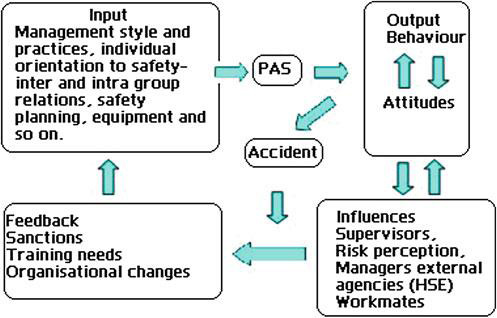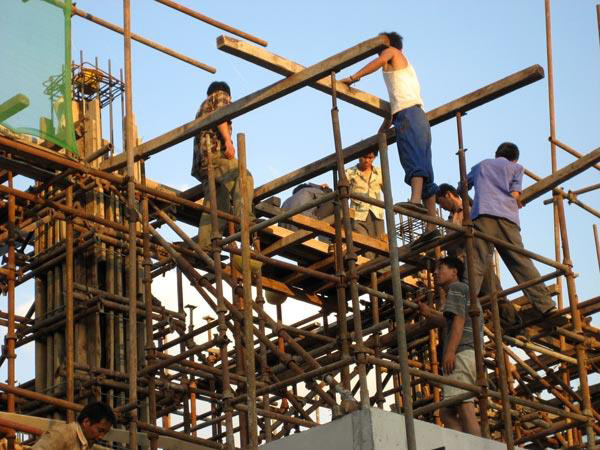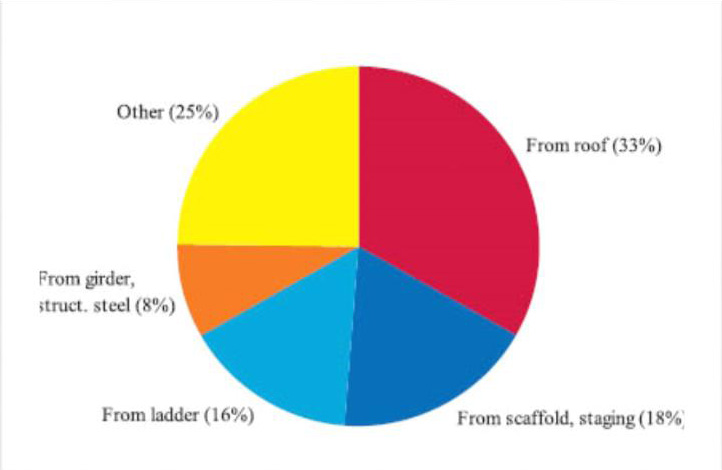Demand for Construction Safety
A Global Perspective
1.0. INTRODUCTION
High accident rate in construction is a universal problem which needs to be tackled by all parties concerned. Although there is, in the last decade, a downward trend in construction accident due to implementation of numerous safety schemes, improvement in construction accident records is still necessary. Accidents impose huge costs on the society including compensation paid for fatal and non fatal accidents. The direct financial costs of accidents are only the tip of the iceberg when compared with the indirect ones. The injured employees and their families suffer from loss of earnings and grief. Accidents on site also lower staff morale induce negative corporate image and lead to extension of time in the project because of work rearrangements
2.0. PAS-POTENTIAL ACCIDENT SUBJECT MODEL
Leather (1987) proposes that both endogenic and exogenic factors might affect the potential accident subject’s acts and thoughts which might lead to accidents in Potential Accident Subject (PAS) model. The PAS stresses the dynamic relationship between various stakeholders on accidents, e.g., workers, managers within the construction companies or even those people who work outside the construction companies. Under PAS model, any person even the victim himself can be the ‘‘Potential Accident Subject’’. Furthermore, people’s behaviours and attitudes are affected by reward, management systems, punishment, training, and instructions given by seniors and so on. Some rewards for finishing tasks quickly may induce workers to take short cuts and ignore the possible sources of risks (Li 2006). Refer Figure 1.

Figure 1- PAS model (Peckitt 2004)
3.0. CONSTRUCTION ACCIDENTS- A GLOBAL REVIEW
The unique characteristics in construction industry such as dynamic environment, change in composition of crews, materials, equipment, challenging work environment and culture make it one of the most high risk industries and is a leading contributor of fatalities at work. Tam and Fung report that around 1.2 million people died of work related diseases and accidents annually and 120 million people became ill or have been injured and incurred a huge economic cost.In the United Kingdom, construction and manufacturing industriesdominated the number of fatal accidents from 1995 to 2000. The construction industry alone represented over 40 % of the total number of fatalities reported among the four industry sectors and was consistently reported as the first or second worst offender for reported fatal injuries (Edwards and Nicholas 2002).
In Australia, the construction industry experienced 37 fatalities, i.e., 5.6 fatalities per 100,000 employees, which was more than double the average for all the industries (2.4 fatalities per 100,000 employees) in 2007–2008 (Zou 2011). In Singapore, construction is also one of the most high risk occupations (the industry accounted for 29 % of the total workers’ expenditures, but accounted for 40 % of worksite accidents) (Imriyas et al. 2007). Apart from the abovementioned developed countries, developing countries share similar safety problems on sites. In Ghana, the Labour Department reports 56 out of 1,120 construction accidents were fatal. This figure is higher than International Labour Organization’s estimates for developing countries.
All these imply the construction industry has a highly conducive environment for human and monetary loss occurrences (Garrett and Teizer 2009) and no doubt that workplace safety indicators such as accident severity rate, fatality rate, injury rate, accident frequency rate as well as the workers and their family members’ pain and suffering often provide important information on demand for safety measures (Ling et al. 2009).
3.1. INDIAN SCENARIO
The work force in the Indian construction industry comprises of 55% unskilled labour, 27% skilled labour, and rest are technical and supporting staff. About 16% of the nation’s working population depends on constructional works for its livelihood. Construction in the developing countries such as India is more labour-intensive than that of the developed countries, involving 2.5-10 times more workers per activity. The labour in the construction industry is most vulnerable because employment is generally temporary in nature, employer-employee relationship is very weak and most of the time short-lived. The work has inherent risk to life and limb due to lack of safety, health, and welfare facilities linked with uncertain working environment. Generally, workers are unskilled which migrate in groups with or without their families, throughout the country in search of employment. Communication problem among these workers due to differences in their language, religion, and culture reduce safety on the work sites.

The Indian construction labour is 7.5% of the world labour force but it contributes to 16.4% of fatal global occupational accidents. It accounts approximately 11% of occupational injuries and 20% of deaths resulting from occupational accidents. In the construction industry the possibility of a fatality is five times more likely than in a manufacturing industry, whereas the risk of a major injury is two and a half times higher. Each year, up to 120 people are killed at work place in the developed countries like UK and there are about 3000 workers who suffer from major injuries in construction-related accidents. Unfortunately, not only construction workers suffer from accidents but, one member of the public, including children is killed each month. This tarnishes the image of the construction industry, and making it more difficult to attract skilled labour.
In the past decade, need for safety awareness among construction companies has greatly increased. This is due to the high cost associated with work-related injuries, workers’ compensation, insurance premium, indirect costs of injuries, and litigation. Every year, a considerable amount of time is lost due to work-related health problems and site accidents. There are several factors responsible for health problems and construction site accidents. The Occupational Safety and Health Administration (OSHA) examined the causes of construction fatalities, result showed that 33% of fatalities in construction were caused by falls, 22% were struck by incidents, 18% were caught in/between incidents, 17% were electrocutions, and 10% were caused by other reasons.
Safety and quality are vital in the construction industry. The industry desires good quality while ensuring a safe working environment at workplace. Pheng and Shiua emphasized that quality and safety should be integrated to achieve better coordination and utilization of resources. Koehn and Datta revealed that issues like poor quality work, unsafe working conditions, and lack of environmental control can be improved by adopting safety rules and regulations. Study, further stressed that the implementation of an effective quality, environment, and safety program not only assures a quality work but also reduces cost and enhances productivity. Ahmed et al. explored that a safe and organized site with good safety rules results in a better adherence to schedules, lower cost, and higher quality.
4.0. CONSTRUCTION ACCIDENTS LAW

Distribution of causes of death from falls in construction
This deals with the personal injury and wrongful death cases resulting from construction accidents, as well as the safety laws, regulations and standards governing the construction industry. The Occupational Safety and Health Administration (OSHA) is the governing regulatory body for construction site safety. Most states have also adopted some form of safety regulations.
Construction accidents can range from minor to catastrophic, and frequently result in death. The types of injuries one can sustain from these accidents include: amputations; blindness; deafness; broken bones, back; burns; coma; concussion; paralysis; severed spinal cord; Traumatic Brain Injury; and much more. These accidents can result from the negligence of others, faulty construction equipment; defective products; defective machines; inadequate safety or equipment training, as well as negligent or reckless co-workers.
Some construction workers are limited by law to receiving only workers’ compensation for their construction injuries. However, in many cases, workers can also recover damages from partially or completely responsible parties, who are not their employer, for causing their injuries, based upon theories of negligence and product liability. If a worker is hurt due to factors other than job safety, such as defective tools or equipment, the injured worker may be able to file a personal injury claim against the manufacturer. They also may be able to recover damages from the owner of the site and the general contractor. The responsible party may be held liable for damages, including medical bills, loss of wages, and pain and suffering.
Various entities may be liable for construction accidents. They include the construction site owner, architects and engineering professionals, contractors, construction managers, and manufacturers of construction machinery or equipment. In some states if an injury results from an OSHA regulation violation, the construction company is negligent and liable for injuries.
5.0. ILO FINDINGS
Some of the findings of the International Labour Organisation (ILO) in the field of construction safety include:
- The accident rate in construction is four to five times higher than that of the manufacturing sector on the global scale. There is an increase in the number of work related diseases associated with construction all over the world.
- After the initial employment, there is a dramatic increase in accident frequency over the following six to eight months. This shows that more workers meet with accidents during the first year of their employment.
- Another study of seven industrialised countries indicated that the average number of such occurrences per 100000 workers was 12 per year, with some countries reporting 35 instances per 100000 workers annually.
- At an all India level, 165 per 1,000 workers get injured during construction activities. This is very high compared to the rates in the developed countries and even certain developing countries.
6.0. CONCLUSION
Researchers and economists have regularly noted deficiencies of safety parameters in construction sites in developing countries including in India. The literature survey indicated that some of the developing countries have not yet developed comprehensive statutory and technical standards for maintaining safety provisions. In case of India, such standards are available. However, despite such requirements the standards are not followed scrupulously. It is high time we take a serious look at Construction Safety and promote necessary awareness.
- Bureau Built Constructions
References
1] Rita Yi Man Li • Sun Wah Poon- Construction Safety
2] The evolution of construction accident causation models - presented in CIB Congress 2010, Manchester.
3] Construction Safety Knowledge for Practitioners in the Construction Industry- Satish Kumar, V.K. Bansal- Department of Civil Engineering, National Institute of Technology, Hamirpur Himachal Pradesh, 177 005, India; Journal of Frontiers in Construction Engineering Jun. 2013, Vol. 2 Iss. 2, PP. 34-42
4] Measuring Construction Site Safety in Kolkata, India, Himadri Guha, Partha Pratim Biswas- International Journal of Scientific & Engineering Research, Volu me 4, Issue 5, May- 2013